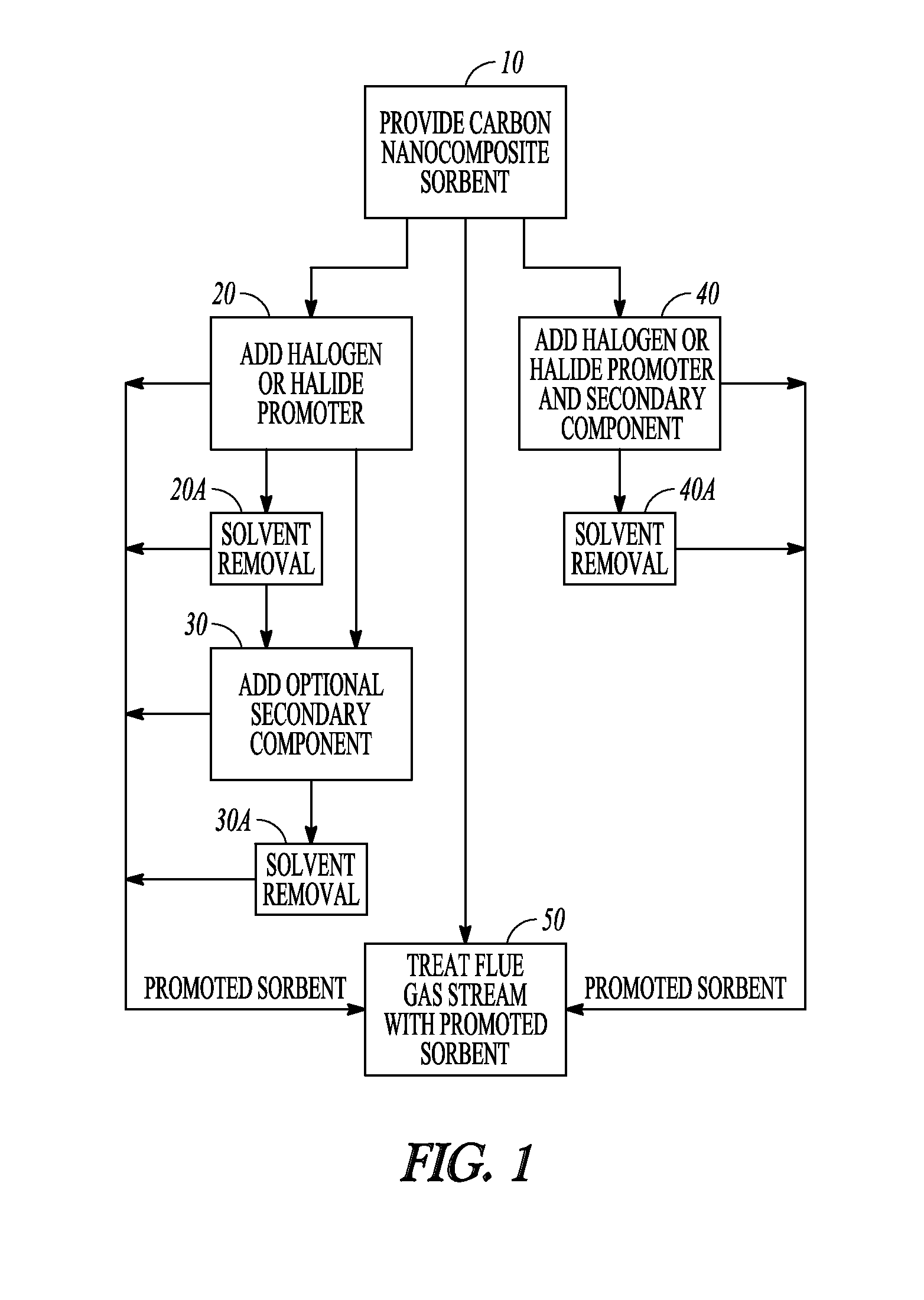Carbon nanocomposite sorbent and methods of using the same for separation of one or more materials from a gas stream
a technology of carbon nanocomposite and sorbent, which is applied in the direction of physical/chemical process catalysts, separation processes, and other chemical processes, can solve the problems of increasing the amount of standard sorbents (e.g., activated carbon) needed to serve the market, increasing the cost of standard sorbents, and reducing the stability of recycling and processing, so as to promote oxidation of pollutants, hinder the sorption of pollutants, and enhance the sorption of pollutan
- Summary
- Abstract
- Description
- Claims
- Application Information
AI Technical Summary
Benefits of technology
Problems solved by technology
Method used
Image
Examples
example process
[0091]In various embodiments, the carbon nanocomposite sorbent, method of mercury removal, and optional additives discussed herein have applicability to mercury control from the product or effluent gas or gases from gasification systems, syngas generators, and other mercury-containing gas streams, in addition to the flue gas from combustion systems. Thus, it should be understood that the terms combustion system and flue gas as used throughout this description can apply equally to gasification systems and syngas or fuel gas, as will be understood by those skilled in the art.
[0092]Referring now to FIG. 1, there is shown a block flow diagram illustrating methods for preparation of promoted carbon sorbents, in accordance with various embodiments. Block 10 illustrates providing carbon nanocomposite sorbent and adding a halogen or halide promoter that reacts with the carbon, illustrated at block 20, to produce a promoted carbon nanocomposite sorbent. In embodiments where a halogen or hali...
example 1
Mesoporous Activated Carbon (AC) Nanocomposites from Commercial Cane Molasses
example 1.1
NanoG-CM
[0116]High-surface-area montmorillonite (clay) obtained from Aldrich (200 g) was added rapidly to Brer Rabbit molasses (nonsulfurated) diluted with a smaller amount of water (200 g / 140 mL) and stirred to make a thick paste.
[0117]As soon as all the clay was wetted with the molasses, the paste was dried overnight at 110° C. to remove excess water. Alternatively, a smaller portion of the paste was heated for 1 min in a microwave. A smaller batch was dried more quickly (1 hour) in the oven at 110° C.
[0118]The dried solid was loaded in two batches in a cylindrical steel tube and heated to 700° C. in a tube furnace with a flow of nitrogen through the bed. The effluent gas was bubbled through a water trap. Heating was continued for 1 hour. The tube was cooled slowly to ambient under nitrogen and emptied. The resulting black chunks of composite carbon were weighed and ground in a mortar and pestle. The product nanocomposite was separated into two sieve sizes, greater than 325 mesh a...
PUM
| Property | Measurement | Unit |
|---|---|---|
| thickness | aaaaa | aaaaa |
| thickness | aaaaa | aaaaa |
| thickness | aaaaa | aaaaa |
Abstract
Description
Claims
Application Information
 Login to View More
Login to View More - R&D
- Intellectual Property
- Life Sciences
- Materials
- Tech Scout
- Unparalleled Data Quality
- Higher Quality Content
- 60% Fewer Hallucinations
Browse by: Latest US Patents, China's latest patents, Technical Efficacy Thesaurus, Application Domain, Technology Topic, Popular Technical Reports.
© 2025 PatSnap. All rights reserved.Legal|Privacy policy|Modern Slavery Act Transparency Statement|Sitemap|About US| Contact US: help@patsnap.com



